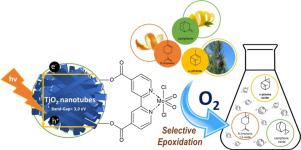Catalysis Today ( IF 5.2 ) Pub Date : 2020-07-30 , DOI: 10.1016/j.cattod.2020.07.053 Henry Martinez Q , Álvaro A. Amaya , Edgar A. Paez-Mozo , Fernando Martinez O , Sabine Valange

|
Selective oxidation of terpenes is a key enabling route to produce value-added epoxides from renewable raw materials. In the present work, the photo-assisted oxygen atom transfer (OAT) to renewable monoterpenes, such as α-pinene, β-pinene, camphene, (R)-(+)-limonene and (S)-(-)-limonene was evaluated with a dichloro-dioxo-Bipy molybdenum(VI) complex (Bipy = 2,2′-bipyridine-4,4′-dicarboxylato) anchored on TiO2 nanotubes (labeled as Mo(VI)Cl2O2Bipy/TiO2-NT) using molecular oxygen as a primary oxidant under benign ambient conditions. Supported MoO3 on TiO2 nanotubes were also used for comparison purposes. Photooxidation of α-pinene with that MoO3/TiO2-NT catalyst resulted in a low conversion and in products distribution similar to that of the parent titania nanotubes, with the ketone as the main product due to a radical process. In contrast, all monoterpenes were successfully oxidized by the Mo(VI)Cl2O2Bipy/TiO2-NT catalyst to the desired epoxides with high selectivities due to the OAT with O2 and UV–vis light. Additionally, the photo-stimulated OAT to (R)-(+)- and (S)-(-)-limonene with the immobilized dioxo-Mo(VI) complex resulted in a diastereomeric excess (d.e.) for the cis-limonene-1,2-epoxide isomers relative to the trans isomers (d.e. = 36 and 34 %, respectively), thereby suggesting that the chiral center in the (R)-(+)- and (S)-(-)-limonene governs the formation of the diastereoisomer. Although not chiral, the Mo(VI)Cl2O2Bipy/TiO2-NT catalyst was shown to act stereoselectively during the OAT process. The high stability of the Mo(VI)Cl2O2Bipy -catalyst under the reaction conditions was also ascertained by recycling studies.
中文翻译:

光辅助O原子与分子氧和固定在TiO 2纳米管上的dioxoMo (VI)配合物转移至单萜
萜烯的选择性氧化是从可再生原料生产增值环氧化物的关键途径。在目前的工作中,将光辅助氧原子转移(OAT)到可再生的单萜,例如α-pine烯,β-pine烯,camp烯,(R)-(+)-柠檬烯和(S)-(-)-柠檬烯用锚定在TiO 2纳米管(标记为Mo (VI) Cl 2 O 2 Bipy / TiO )上的二氯-二氧代-Bipy钼(VI)络合物(Bipy = 2,2'-Bipyridine-4,4'-dicarboxylato)进行评估2- NT)在良性环境条件下使用分子氧作为主要氧化剂。TiO 2上负载的MoO 3纳米管也用于比较目的。用该MoO 3 / TiO 2 -NT催化剂对α- pine烯进行光氧化会导致较低的转化率和与母体二氧化钛纳米管相似的产物分布,其中酮为主要产物是由于自由基过程。相反,由于OAT与O 2和紫外可见光作用,所有单萜都被Mo (VI) Cl 2 O 2 Bipy / TiO 2 -NT催化剂成功氧化为所需的环氧化物,具有高选择性。此外,用固定化的二氧杂钼(VI)配合物对(R)-(+)-和(S)-(-)-柠檬烯进行光刺激的OAT导致非对映体过量(de)相对于反式异构体的顺式-柠檬烯-1,2-环氧异构体(分别为de = 36%和34%),从而表明(R)-(+)-和(S)- (-)-柠檬烯控制非对映异构体的形成。Mo (VI) Cl 2 O 2 Bipy / TiO 2 -NT催化剂虽然不是手性的,但在OAT过程中表现出立体选择性。还通过循环研究确定了Mo (VI) Cl 2 O 2 Bipy催化剂在反应条件下的高稳定性。











































 京公网安备 11010802027423号
京公网安备 11010802027423号